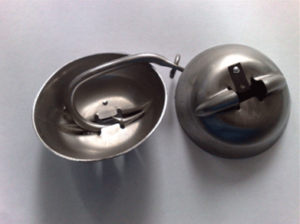Smart Tuna Hook
WHAT ARE SMART TUNA HOOKS?
Smart Tuna Hooks are a type of hook protection device for use in pelagic longline fisheries (designed originally for tuna fisheries, with potential to be applied to others). They aim to prevent hooking of seabirds and turtles during line setting, by encapsulating the baited hook in a metal shield. The metal shield, manually clipped to the baited hook during the baiting process, is held in place by a biodegradable pin which corrodes on contact with seawater.
As the hook sinks through the water column, the pin continues to dissolve, eventually disintegrating after around 15 minutes of immersion, releasing the shield to expose the baited hook. At this depth, the exposed hook is safely out of reach of seabirds, reducing the incidence of bycatch. The metal shield, now detached from the gear, sinks to the seabed and corrodes within 12 months into its constituent parts – iron oxide and carbon.

Source: Oceansmart

Source: www4.fisheries.go.th
CURRENT RESEARCH & USE
Following assessment in 2016 by the Agreement for Conservation and Albatrosses and Petrels (ACAP), smart tuna hooks have been recommended best practice for mitigating bycatch in pelagic longline fisheries.
Smart tuna hooks have been trialled in the South African tuna/swordfish pelagic longline fisheries and reported a reduction in seabird bycatch of 81.8% – 91.4%. Additionally they reported no detrimental effect on target catch rate.
Operational trials have been conducted in the Australian Eastern tuna and billfish fishery and indicated that the smart hooks performed well in a commercial setting. The crew adapted readily to the deployment of the devices, commenting that they are easier to use than lead weights (over which there are safety concerns).
It should also be noted that smart tuna hooks may perhaps reduce the need for lead weights altogether as they have been measured to similarly increase the sink rate of baited hooks (weighing 40g minimum weight).
This page was last updated on 12.02.21.
Interested in how this and other measures could mitigate bycatch in your fishery? Get in touch with us to collaborate or take part in a study.
